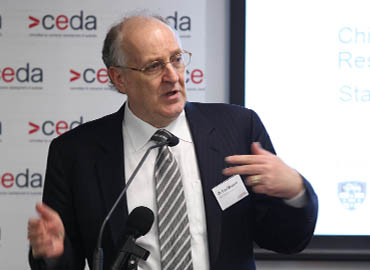“For the last four to five years the global economy has been growing at about 3.5 per cent and we are expecting continued growth of 3.5 per cent and higher with modest expansion,” Standard & Poor’s Rating Services Chief Global Economist, Dr Paul Sheard told a CEDA audience.
 “The current global economic risks include China, the Eurozone, and the Federal US Reserve’s normalisation of monetary policy,” Dr Sheard said.
“The current global economic risks include China, the Eurozone, and the Federal US Reserve’s normalisation of monetary policy,” Dr Sheard said.
“Since the first quarter of 2008, China’s quarterly growth year-on-year has been more than eight per cent, with Australia a big beneficiary.
“In fact, China’s growth has averaged 9.9 per cent and its economy has been doubling every seven years for the last 35 years, making it the second largest economy in the world.”
According to Dr Sheard, the challenge lies with China’s 1.3 billion population and its relatively low per capita income: the Chinese government is now undertaking a huge and ambitious reform program and the long-term risk is that the government might be distracted from this reform program while it worries about maintaining growth.
“The market is suspicious and nervous but what’s happening now is really just part of China’s reform process.
“China has been trying to get the IMF to include the yuan in SDRs (Special Drawing Rights) despite China’s extensive capital controls. But first the IMF wants the yuan to become more market-oriented. That’s what’s behind the current correction,” Dr Sheard said.
“But we shouldn’t worry: if the Chinese economy looks like tanking, they will act.
“New Chinese growth is expected to be around 6.5 per cent.
“The United States is an economy in recovery. It has been ever since 2008 when the policy-makers threw out the rule book and stabilised the banking system.
“Since mid-2009, the US economy has maintained growth of 2.1 per cent. It’s just that the Fed operates on a zero interest rate monetary policy incorporating quantitative easing.
“Everybody overreacts and thinks QE is just printing money. But it isn’t.
The Fed plans to retain the current balance sheet level, keep QE in place and slowly raise the interest rate.
“Then they will allow the balance sheet to unwind – as securities mature, allow them to drop off the balance sheet.
“Currently, the Eurozone is the most interesting and complex global issue.
“It has taken five years, but the European Central Bank has finally started to embrace quantitative easing, which is now providing stimulus to the European economy.
“The sovereign debt crisis is because of the EU’s problematic economic architecture. The EU is a monetary union, but not a fiscal union. This means that each country has relinquished its macro-economic policy tools and adopted the overall EU policies.
“For example, on one hand the Greek GDP is extremely low while the German GDP is high. So they both need very different monetary policies. But both are working under the same policies.
“According to the recent ‘Five Presidents’ Report’, the EU architecture is fatally flawed. It needs a fiscal union, but currently there is no appetite for one.
“The process of fixing Europe’s problem will go on for many years and weigh it down for a long time to come.”